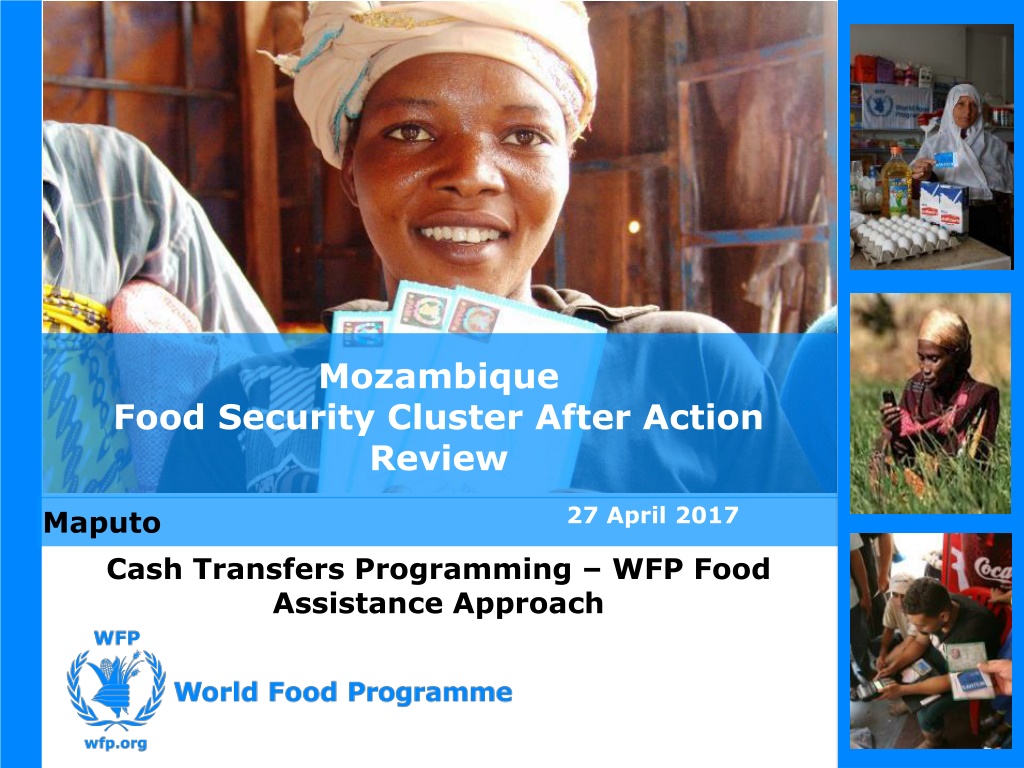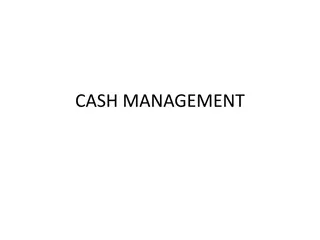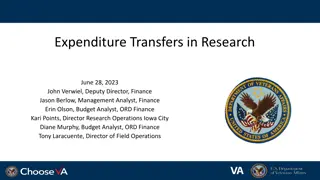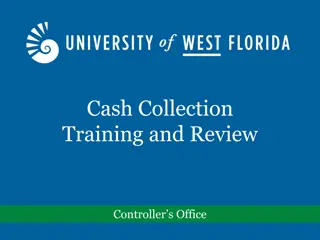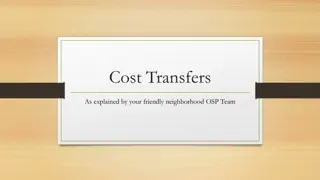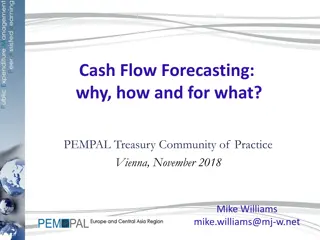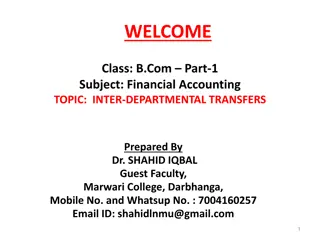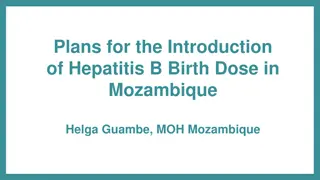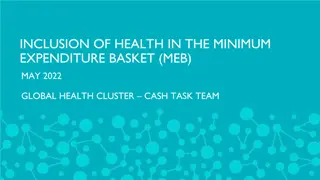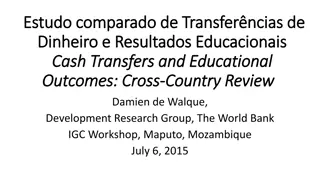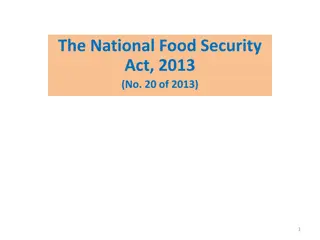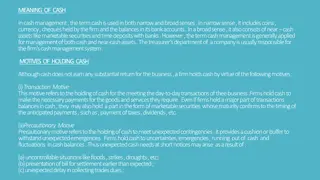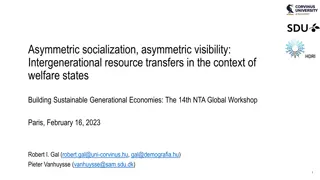Enhancing Food Security through Cash-Based Transfers in Mozambique
Explore the use of cash-based transfers in humanitarian assistance, focusing on addressing food security challenges in Mozambique. The presentation covers the objectives, definitions, programming types, and the transition from food aid to food assistance through cash interventions. Discover key considerations, lessons learned, and practical options for wider adoption of cash-based transfers.
Download Presentation

Please find below an Image/Link to download the presentation.
The content on the website is provided AS IS for your information and personal use only. It may not be sold, licensed, or shared on other websites without obtaining consent from the author. Download presentation by click this link. If you encounter any issues during the download, it is possible that the publisher has removed the file from their server.
E N D
Presentation Transcript
Mozambique Food Security Cluster After Action Review 27 April 2017 Maputo Cash Transfers Programming WFP Food Assistance Approach
Cash Based Transfers Objectives of the Presentation Ensure common understanding of what cash based transfers are and applicability in humanitarian assistance Address the basic pillars of food security and principles of response Discuss response analysis and distribution modality / delivery mechanism choice Present audience with some practical options on wider adoption of CBT
WFP Cash-Based Transfers Presentation Outline I. Overview of Cash Based Transfers Programming II.Food Security Overview & the WFP Food Assistance Toolkit III.Key Considerations and Lessons Learnt in CBT
Part I Overview of Cash Based Transfers Programming
Cash Based Transfers Definitions Cash transfer programming in emergencies is one form of humanitarian response which can be used to address basic needs and/or protect, establish or re- establish livelihoods. Transfer of resources using market mechanisms. (WFP) As such responds to problem of access not availability , e.g. people can t afford food, where there is no shortage. IFRC and ICRC Guidelines for cash transfer programming C&V = cash & vouchers CBI = Cash-Based Interventions MBI = Market Based Interventions CTP = Cash Transfer Programming Cash transfers are assistance to beneficiaries in the form of cash payments, bank transfers or mobile money. Beneficiaries can meet their own needs in the marketplace. (CaLP)
Cash Based Transfers Programming Types of CBT Programmes Cash Based Transfers Cash Vouchers Commodity Value
Cash Based Assistance Why the Transition from Food Aid to Food Assistance? Food insecurity results from different factors calling from diverse response options One Size Does Not Fit All Shift to people centric approaches (putting beneficiaries at the centre of their support) Focus on local food production & market development Social-economic factors: cost efficiency & effectiveness considerations
Part II Food Security Overview & The WFP Food Assistance Toolkit Response Decisions
Food Assistance What is Food Security? an evolving concept ... Current Definition: Food security is achieved when all people, at all times, have physical, social and economic access to sufficient, safe and nutritious food to meet their dietary needs and food preferences for an active and healthy life. 1950s 60s food security was equated with self sufficiency in major staples 1974 Food Security is defined as Access to Sufficient food
Food Security Pillars of Food Security AVAILABILITY ACCESS UTILIZATION STABILITY * WEATHER VARIABILITY * PRICE FLUCTUATIONS * POLITICAL FACTORS * ECONOMIC FACTORS *FOOD SAFETY *HYGIENE AND MANUFACTURING PRACTICES *DIET QUALITY AND DIVERSITY *PURCHASING POWER *INCOME OF POPULATION *TRANSPORT AND MARKET INFRASTRUCTURE * DOMESTIC PRODUCTION * IMPORT CAPACITY * FOOD STOCKS *FOOD AID IN-KIND / VOUCHER BCC / KNOWLEDGE / MITIGATION CASH / VOUCHER LEGISLATION
Food Security WFP s Food Assistance Tool-Kit Food Assistance In-Kind Cash Vouchers
Food Security The Food (Nutrient) Gap The food gap is the difference between nutritional needs and what targeted beneficiaries are able to provide for themselves without adopting distressed strategies. Food Gap Nutritional household themselves negative coping strategies. Value is without of the to food the for to able provide resorting Needs Assessments determine the food gap in a given food insecurity context.
Food Security How to Meet the Food Gap In-kind food WFP Food Basket Transfer Value determined by the minimum Nutritionally Balanced Food Basket available in the market Cash- Based Transfers
Food Security What is a Nutritionally Balanced Food Basket Available in the Market? A basket made of food commodities available in the local market, preferred by the beneficiaries as per diet habits, nutritious enough to fill the identified food gap! THIS IS ALSO KNOWN AS The LOCAL DIET BASKET
Food Security How to Calculate the Transfer Value Once the local diet basket is defined in commodities and quantities, we apply the local market prices: Food Basket Food items and associated quantities calculated to fill the food gap (Kcal + macro + micro nutrient requirements) In-kind Food gap: Nutrient Value -Energy Kcal -Macronutrients - Micronutrients food Food Basket Transfer Value Food items tailored on local diet. Associated quantities calculated to fill the food gap (Kcal macro + micro nutrient) Cash-Based Food basket (items & quantities) Local market prices Transfers
Comparative Decision Making Processes Sectorial Capacity Assessment Considerations Cooperating Partners Capacity Financial Services Capacity IT and Communication Capacity OPERATIONAL CAPACITY Local Market & Retail Sector Capacity Field Security Assessment Government Policies
Transfer Modality Choice Cost Efficiency and Effectiveness Considerations Cost-Efficiency Measures the cost of Delivering the Programme Cost-Effectiveness Measures the cost of achieving the objective
Part III Key Considerations in Cash Based Transfers
Partnerships Working with non-traditional Partners Financial Services Providers Traders (not as typical providers of commodities) (Third Party) Technology Providers Other Government Ministries and Department Relationship Spectrum PARTNERSHIP TRANSACTIONAL At one end of the spectrum are simple transactional partnerships for leveraging resources; at the other end are full-scale, complex multi-sector partnerships which aim to bring about system change. And of course there are many points in between, but for simplicity we have picked out a central point of combining to innovate .
Partnership Outcome of misalignment
Markets Market based responses need markets Market functionality a key success determinant Market assessments prior to intervention key Market monitoring during intervention essential It is good practice to build on what the target population has (markets created for humanitarian responses tend to collapse with the intervention) Why do different market assessment arrive at different conclusions?
Financial Services Providers Access to and interaction with FSPs Financial inclusion a large portion of the population remains outside the financial grid (KYCs, regular income, costs et al limit access) Adopted financial services shouldn't be a burden to target population clear point of payment and verification of recipient (right amount to the right person at the right time) The aim is not technology but rather adoption of appropriate mechanism Technology can limit risk of fraud Technology can limit access to financial services
Delivery Mechanisms Criteria for Assessment Cash Delivery Options Project Objectives (including duration of assistance & transfer value) Existing infrastructure Set up costs Security considerations Controls & risk mitigation measures (automation) Human resources requirements (#s & capability) Speed for execution (fast or slow onset emergency?) Acceptability by target & vulnerable groups Scale Flexibility to amounts, frequency et al
Technology Sample Considerations Biometrics e.g. use of finger prints can achieve deduplication, erase need for PIN numbers Mobile Phones use for mobile money; remote monitoring tool on project variables; accountability to affected population (AAP) messaging BCC, notification of abuse SMART card multiple wallet capability, data encryption, ability of offline transactions IMS e.g. SCOPE from WFP enable beneficiary and transfer management
Government Legislation and political will Data protection what information can be collected? Informed (beneficiary) consent
Working together Coordination and collaboration Cash Working Groups a good place to discuss cash issues Cross sectorial linkages useful Government linkages essential (both local and national) Joint studies, programmes contribute to collective learning Enables addressing competing narratives on key issues like transfer value and thresholds for changing transfer modality
Lessons Learnt Critical Success Factors Business engagement is not about CSR! It is about a social-business interaction that MUST make sense to all actors Technology shouldn t be adopted for the sake of technology sometimes low-tech makes most sense Government ownership and leadership key! Coordination and collaboration among stakeholders is essential (CWGs) Always ensure AAP they have to be informed and involved
Q&A Session Charles Inwani Programme Policy Adviser CBT & Social Protection, Regional Bureau of Johannesburg, South Africa charles.inwani@wfp.org World Food Programme World Food Programme Learn more: http://www.wfp.org/cash-and-vouchers http://go.wfp.org/web/cash-and-vouchers/home 27th April 2017
